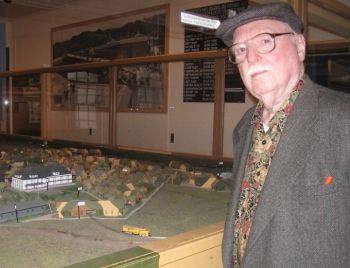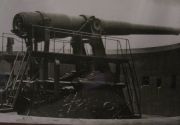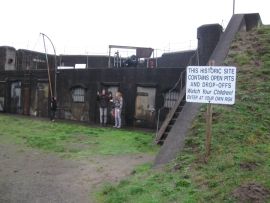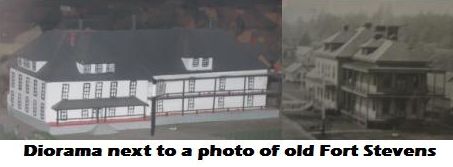
Publisher:
Bonnie King
CONTACT:
Newsroom@Salem-news.com
Advertising:
Adsales@Salem-news.com

~Truth~
~Justice~
~Peace~
TJP
Dec-05-2008 22:07

 TweetFollow @OregonNews
TweetFollow @OregonNews
WWII Veteran Has Special Connection to Old Fort Stevens
Tim King Salem-News.comFort Stevens abounds with historical sites and experiences. For Dr. Phil Leveque the old base has a personal connection; his father served here.
 Dr. Phillip Leveque's father, Charles Leveque, once was in charge of the fort's mammoth coastal defense guns in the pre-war years. Salem-News.com photo by: Bonnie King |
(FORT STEVENS, Ore.) - If you let your imagination go at old Fort Stevens on the north Oregon coast, you can almost hear the sounds of the big guns that once roared and shook the ground here, but today lay silent as a testimony to another time in history.
 One of Fort Steven's big guns |
"It is very underrated, because this is a Civil War fort," Stillick said. He pointed out that the area was actually colonized in 1812. More interestingly, it was a Native American fort prior to the white man's arrival used to guard and protect fishing in the area.
Salem-News.com's Dr. Phil Leveque agrees, saying the level of historical importance is extremely high when it comes to Fort Stevens and the Civil War.
"Because they thought the South might try to invade the west by going up the Columbia River," Leveque said.
Dr. Phillip Leveque is a WWII combat veteran and one of Oregon's leading experts on the Second World War. He's familiar with Fort Steven's history, and he also has a special connection to this place. His father, Charles Leveque, once was in charge of the fort's mammoth coastal defense guns in the pre-war years.
"He was in charge of them. I don't know if that means he was the one who fired them or what the hell it was, but he was the sergeant of the gun," Leveque said.
"I mean they were as heavy as heavy battleship artillery."
He explained that his father was a bit of a prankster, and one of his offbeat plans led to an early return home for some Oregon Guard soldiers.
"He calculated, the time it took for the barges to go up and down with the waves, and the barge had a big target on it. They were trying to shoot at the target. He thought he'd play some games, he timed it so the barge was at the top of the wave, and he sunk the barge!"
Leveque says his father's National Guard coastal defense group went home early that time, because there was nothing left for the crews to practice shooting.
Attack on U.S. Soil
 All lighthearted tales aside, Fort Stevens was a serious place for many years and as it turned out, there was good reason for the gun crews to practice.
All lighthearted tales aside, Fort Stevens was a serious place for many years and as it turned out, there was good reason for the gun crews to practice.
During World War Two, a Japanese submarine shelled Fort Stevens. It was officially, the only place in the Continental U.S. where enemy shells struck our shores.
While the old gun emplacements and numerous buildings and foundations can be seen here, one of the biggest attractions at this historical Oregon military fort is found inside the Fort Stevens Visitor Center.
Displays account for different periods in the fort's history, with uniforms and artifacts and other interesting items. World War One was an active time for the base. This display contains numerous U.S. Army Division patches representing soldiers that served here and at other military installations.
Diorama of Fort Stevens in 1942
One fantastic display is a highly detailed diorama showing what Fort Stevens looked like during World War Two.
 Stillick says blue prints from the construction of Fort Stevens were located and allowed the almost-scale model of the fort as it appeared in 1942 to be constructed.
Stillick says blue prints from the construction of Fort Stevens were located and allowed the almost-scale model of the fort as it appeared in 1942 to be constructed.
Another volunteer at Fort Stevens, Don Carter, explains that simple blocks of wood were used to construct the dozens of buildings. Carter says they found original photographs that showed the actual camouflage patterns used at that point.
World War Two lasted six years and led to the deaths of millions. Visiting a place like this brings back a lot of memories for Dr. Phil Leveque, who was a point man in an infantry squad shortly after the Battle of the Bulge.
Fort Stevens is an amazing place to visit, and it abounds with historical sites and experiences. The old military installation is off the beaten path, and volunteers like Roger Stillick, say more Oregonians need to make time to discover Fort Stevens.
Articles for December 4, 2008 | Articles for December 5, 2008 | Articles for December 6, 2008
Salem-News.com:





Terms of Service | Privacy Policy
All comments and messages are approved by people and self promotional links or unacceptable comments are denied.
[Return to Top]
©2025 Salem-News.com. All opinions expressed in this article are those of the author and do not necessarily reflect those of Salem-News.com.